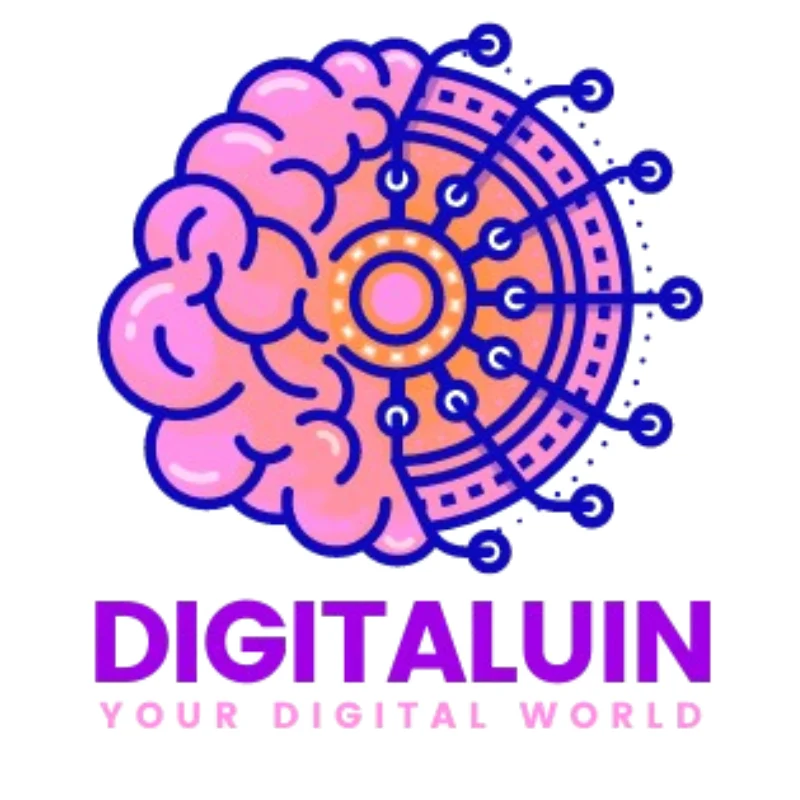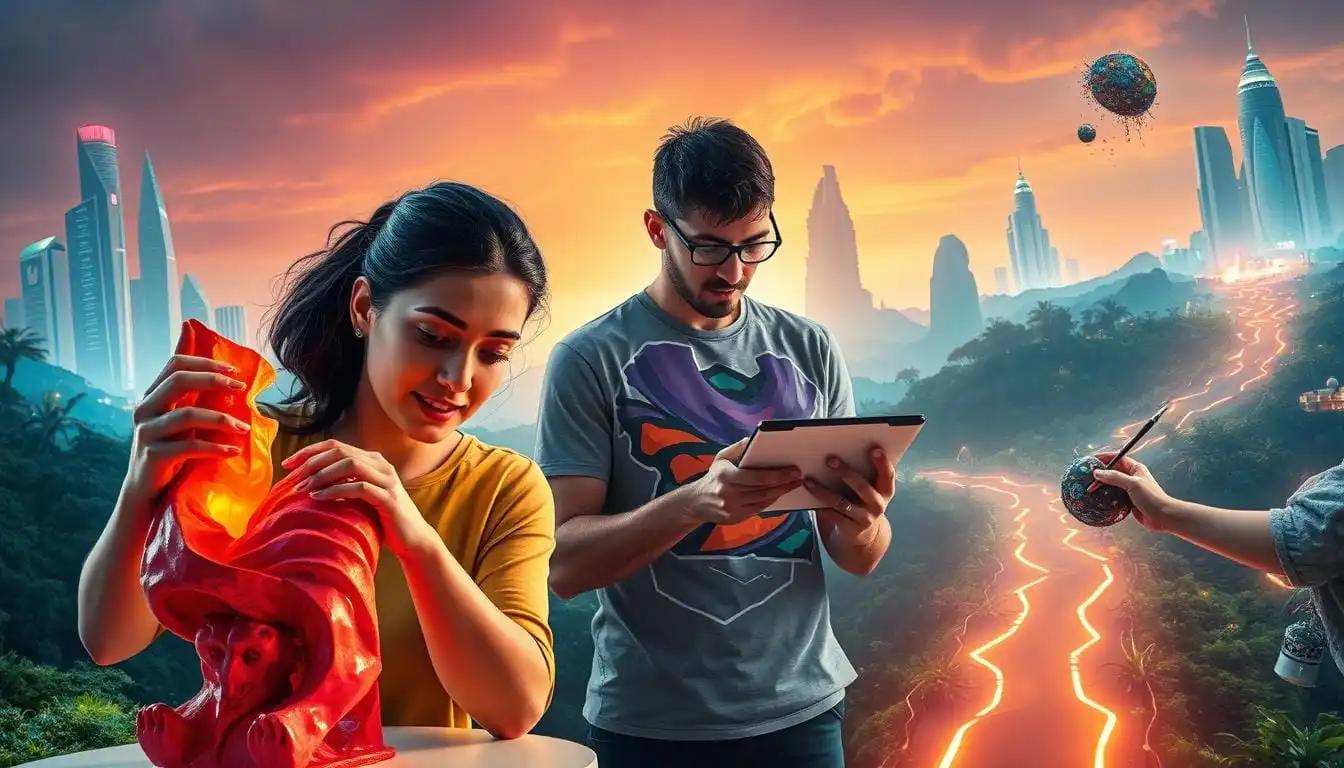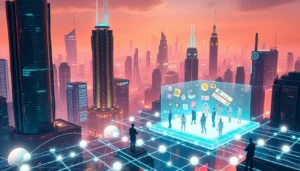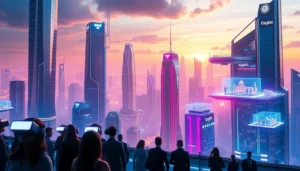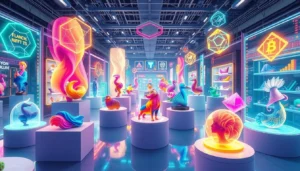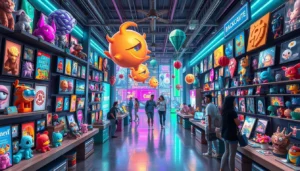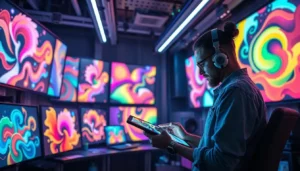NFT Artists: How Blockchain is Empowering Creators
Digital art and blockchain are reshaping creativity in ways we’ve never seen before. Non-fungible tokens (NFTs) have changed how creators share and sell their work. NFT artists now have the power to engage with their audience without intermediaries.
Imagine turning your art, music, or other creative projects into tokens. This lets you control your work and talk directly to your fans. Many blockchain artists are making this a reality.
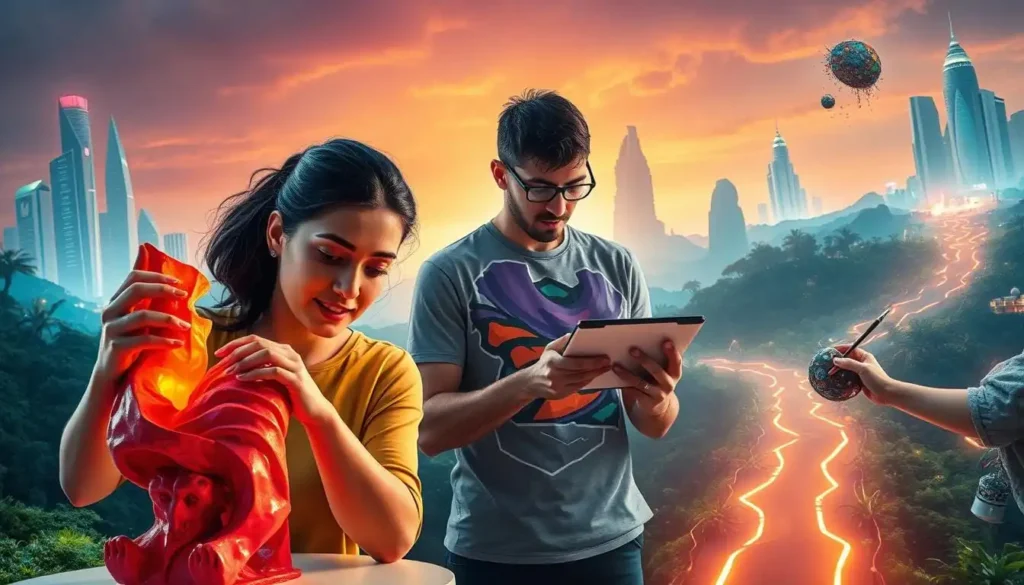
Blockchain technology lets creators make money from their digital content in new ways. This change is empowering a new group of artists. It’s also reshaping the art world.
Table of Contents
The Digital Art Revolution: Understanding NFTs
NFTs are accelerating a seismic shift in how digital art is created, traded, and valued. NFTs are rewriting the rules of digital creativity, turning ephemeral pixels into authenticated assets with verifiable provenance and social utility. You’re joining a growing group that’s exploring NFTs’ role in the art world.
What Are Non-Fungible Tokens and Their Significance
Non-fungible tokens (NFTs) serve as verifiable proof of authenticity for one-of-a-kind digital assets. They use blockchain technology. NFTs have solved digital art’s big problems by making it safe and clear to show who owns what.
NFTs address a critical challenge in digital art: establishing indisputable ownership. They let artists sell their digital work in a way that shows it’s unique and owned. This innovation unlocks fresh revenue streams for creative minds.
| Key Features of NFTs | Description | Benefits |
|---|---|---|
| Uniqueness | NFTs represent unique digital assets. | Proves scarcity and ownership. |
| Blockchain Technology | NFTs are powered by blockchain technology. | Ensures secure and transparent ownership. |
| Ownership | NFTs provide proof of ownership. | Empowers artists and creators. |
The Digital Revolution: Redefining Art Ownership in the Virtual Age
The transition from physical to digital ownership is challenging traditional notions of artistic worth. You can now own and collect digital art in ways you couldn’t before. This change lets artists sell their digital work and collectors buy unique digital pieces.
As digital art keeps evolving, NFTs are key in shaping art ownership. With NFTs, artists and collectors gain unprecedented security and transparency.
Blockchain Technology: The Foundation of NFT Art
Blockchain technology is key for NFT art. It makes it safe and clear to create and sell your art. It’s not just a helper; it’s the main part that lets you make, sell, and own unique digital art.
Blockchain technology is tackling long-standing issues in the art industry. It makes sure your art is real, rare, and pays you when it’s sold again. It uses a network that’s not controlled by one person, making your art as special as any real art.
Decentralized Ledgers and Digital Scarcity
At the core of blockchain is the decentralized ledger. It makes digital scarcity possible. This is big in the digital world, where copying is easy. Blockchain lets you prove your art is unique and rare, just like real art.
Blockchain’s immutable ledger ensures NFT ownership remains tamper-proof. This makes the NFT art market strong. It reassures buyers that their art is real and rare.
Smart Contracts: Automating Artist Royalties and Transactions
Smart contracts are a big plus for NFT art creators. They are programs that do things on their own. They make sure you get paid when your art is sold again, keeping your income flowing.
Smart contracts make things easier and cheaper. Eliminating intermediaries reduces costs and enhances efficiency. This is great for NFT artists, as it means they keep earning from their art.
| Feature | Benefit to NFT Artists | Impact on the Art Market |
|---|---|---|
| Decentralized Ledgers | Verifiable ownership and scarcity | Increased trust and authenticity |
| Digital Scarcity | Unique digital art | New market opportunities |
| Smart Contracts | Automated royalties on resales | Continuous income for artists |
Leveraging blockchain’s capabilities maximizes the potential of NFT artistry. Your art will be unique, valuable, and will keep earning money over time.
How NFT Artists Are Transforming the Creative Economy
Artists are changing the creative economy with NFTs. NFTs are rewriting traditional norms and setting new industry standards. This change affects how art is made, shared, owned, and enjoyed.
Breaking Free from Traditional Gatekeepers
The old art world had gatekeepers like galleries and critics. They decided what art was good. Blockchain enables artists to bypass galleries and sell directly to supporters.
This new way lets artists control their work more. It also brings in more kinds of art. New NFT artists get noticed without needing old art world approval.

Direct-to-Collector Relationships and Community Building
NFTs help artists connect directly with fans. This builds a community and a strong bond. Creatives can showcase their work and gather real-time feedback.
This connection also helps artists build a community. Fans can support their favorite artists by buying NFTs and joining events. This makes the art world more vibrant and supportive.
Democratizing Access to the Global Art Market
NFTs make the art market more open. Artists from everywhere can show their work. Emerging NFT artists can reach fans all over the world.
This openness helps collectors, too. Collectors can discover rising talents and acquire exclusive digital pieces. The NFT art world is becoming more diverse and welcoming.
Financial Empowerment Through Blockchain for Creators
The world of crypto art NFT is opening up new financial opportunities for artists. As an NFT art creator, you’re not just limited to the traditional art market. You’re entering a global, decentralized economy where your work can be valued and compensated in new and innovative ways.
NFTs offer a range of financial benefits that were previously unavailable to artists. One of the most significant advantages is the ability to earn royalties on secondary sales. This ensures that you continue to benefit from your work even after it’s been sold.
Royalties in Perpetuity: Secondary Sales Income
With NFTs, you can program royalties into your smart contracts. This guarantees a percentage of the sale price every time your artwork is resold. This feature provides a steady stream of income and incentivizes collectors to support artists they believe in.
For instance, if you sell an NFT artwork for 1 ETH and set a 10% royalty, you’ll earn 0.1 ETH every time it’s resold. Over time, these earnings can accumulate into a substantial income. Financial independence allows artists to sustain and expand their craft.
New Revenue Streams Beyond Traditional Art Sales
NFTs are not just about selling art; they’re about creating new revenue streams. You can monetize your work through various means, such as:
- Premium perks reserved for NFT holders, such as VIP access or bonuses
- Monetize your artwork by licensing NFTs for commercial applications
- Creating limited editions or series, increasing the scarcity and value of your work
These opportunities allow you to diversify your income. They help build a more sustainable career as an NFT art creator.
Tokenomics and Artist-Driven Economies
Tokenomics refers to the economics and design of token-based systems, such as those used in NFT marketplaces. As an NFT art creator, you can leverage tokenomics to build your own economy around your work. This might involve creating a token that grants access to exclusive content, voting rights, or other benefits.
| Tokenomics Feature | Description | Benefit to NFT Art Creators |
|---|---|---|
| Token-based governance | Allows holders to participate in decision-making processes | Empowers creators to build a community-driven economy |
| Exclusive content access | Grants holders access to exclusive content or experiences | Creates new revenue streams and incentivizes collector engagement |
| Token staking | Allows holders to stake tokens in exchange for rewards or benefits | Provides a new way to reward loyal collectors and supporters |
By understanding and leveraging tokenomics, you can create a thriving economy around your NFT artwork. This further enhances your financial empowerment as a creator.

Prominent NFT Marketplaces for Digital Artists
Choosing the right NFT marketplace is key for artists in the digital art world. The NFT scene is growing fast, with many platforms popping up. Each marketplace offers distinct advantages tailored to different creators.
The NFT landscape has become a boundless gallery where pixel art coexists with generative masterpieces and everything in between; no creative vision is too unconventional. Understanding platform options helps NFT artists broaden their reach and sales.
Ethereum-Based Platforms
Ethereum-based platforms are very popular. They include OpenSea, Foundation, and SuperRare. Leading NFT platforms host extensive collections of digital masterpieces.
- OpenSea: A premier hub for diverse NFTs with an intuitive browsing experience.
- Foundation: A platform that focuses on supporting creators and offers a curated experience.
- SuperRare: A curated space for rare, high-caliber digital artworks.
Alternative Blockchain Marketplaces
Other blockchain platforms are also important in the NFT world. Solana, Tezos, and Flow are examples. They offer benefits like lower fees and faster transactions.
For emerging NFT artists, these platforms can be a good starting point. These platforms lower entry barriers for newcomers to the NFT scene.
| Platform | Blockchain | Fees | Features |
|---|---|---|---|
| OpenSea | Ethereum | Variable gas fees | Large user base, wide range of NFTs |
| Foundation | Ethereum | Gas fees apply | Curated platform, supports creators |
| SuperRare | Ethereum | Gas fees for minting | High-quality, limited-edition art |
| Solana | Solana | Low transaction fees | Fast transaction times, eco-friendly |
Choosing the Right Platform for Your Art Style and Goals
When selecting a marketplace, consider fees, usability, and artistic alignment. New NFT artists should find platforms that match their art and goals.
Knowing what each marketplace offers helps you choose the best one for you. This ensures seamless focus on creativity rather than technical hurdles.
Creating and Minting Your First NFT Artwork
Turning your digital artwork into an NFT requires a methodical, step-by-step approach. You’ll need to learn about the tools and platforms used in this process.
Essential Tools and Software for NFT Creation
Creating NFT art begins with mastering digital design tools. Popular choices include:
- Adobe Photoshop for raster graphics
- Illustrator for vector graphics
- Blender for 3D modeling
You also need to prepare your art for minting. Prepare your files by resizing, formatting, and optimizing for NFT platforms.
Setting Up Your Crypto Wallet and Marketplace Account
To mint and sell NFTs, you must set up a crypto wallet and marketplace account. Here’s how to do it:
- Choose a Crypto Wallet: MetaMask is a top choice for NFT artists because it works with many blockchain networks.
- Cryptocurrency funding is essential to mint and list your NFTs. The type needed depends on the blockchain and marketplace.
- Choose a marketplace that aligns with your artistic vision and objectives. OpenSea, Foundation, and SuperRare are popular choices.
- Create a Marketplace Account: Set up your account by following the marketplace’s instructions. Most platforms require linking a compatible crypto wallet for transactions.
The Minting Process: Step-by-Step Guide
Once your artwork, wallet, and marketplace are set, you’re ready to mint. Here’s how:
- Upload Your Artwork: Upload your digital art according to the marketplace’s instructions.
- Set NFT Details: Add details like the NFT’s name, description, and attributes.
- Configure Royalties: Set royalties for secondary sales, if allowed by the marketplace.
- Mint the NFT: Complete the minting phase by authorizing the transaction through your connected wallet.
By following these steps, you’ll create and mint your first NFT artwork. This marks a pivotal entry into the world of blockchain-powered art.
Marketing Strategies for Emerging NFT Artists
For budding NFT artists, a compelling online presence is crucial. The digital art world is getting more competitive. Good marketing strategies amplify visibility and attract potential buyers.
Building Your Digital Presence and Personal Brand
First impressions in the digital art world are often formed by your online and personal presence. Creating a professional website is vital. It should show your NFT art, share your creative journey, and guide interested collectors.
Being consistent is important for your personal brand. Make sure your branding, like your logo and colors, is the same everywhere online.
Leveraging Social Media and NFT Communities
Social media is a great way for NFT artists to show their work, talk to collectors, and grow their art community. Sites like Twitter, Instagram, and Discord are favorites among NFT fans.
To make the most of social media, post interesting content. Offer exclusive insights, previews, and interactive discussions.
- Share your NFTs with professional-grade visuals and animations
- Build a loyal following by interacting authentically with your audience’s feedback
- Join forces with other artists and influencers to grow your influence
Collaborations and Drops: Creating Buzz Around Your Work
Working with other artists or brands can bring in new fans and create special NFT art. Limited releases generate buzz and drive collector urgency.
Promote collaborations and drops through social media and community outreach. Reward early supporters with unique incentives to boost sales.

Navigating Obstacles and Controversies in the NFT Art World
The NFT art world is facing big challenges that might affect its future. As you dive into NFTs and crypto art, knowing these challenges is key. They could change the digital art scene a lot.
Market Volatility and Investment Risks
The NFT market is highly volatile, with rapid price fluctuations. This makes it hard for artists and collectors to know what their NFT artwork is worth. NFT investments carry inherent risks, including potential financial loss.
The NFT market is also very speculative. This can make prices too high, making it hard for real artists to be seen. So, it’s important to be careful and do your homework before investing.
Copyright Infringement and Intellectual Property Issues
Copyright issues are a big worry in the NFT world. While NFT creation is simple, plagiarism remains a pressing concern. Ensure you hold full legal rights to monetize your NFT creations.
The very feature that makes blockchain powerful, its distributed authority, becomes its greatest challenge when protecting creators’ rights across borderless networks. As an artist or collector, you must know how to protect your work and investments.
Accessibility Barriers and Technical Hurdles
The NFT world is new, and there are many technical problems to solve. Creating and minting NFTs can be hard and requires a lot of tech knowledge. You might need to learn about blockchain, cryptocurrency, and digital wallets.
There’s also the issue of blockchain’s environmental impact. As you explore NFT art, think about these concerns and look for greener options.
In short, the NFT art world offers many chances for artists and collectors. But it’s important to know the challenges and criticisms. This way, you can make smart choices and move through the NFT world with confidence.
Environmental Concerns and Sustainable NFT Practices
NFTs are becoming more popular, but they raise big environmental worries. As an NFT artist, you’re pioneering a new frontier in digital expression. You’re also part of a bigger talk about being green in the NFT world.
The big issue with NFTs is how much energy they use. This depends on the blockchain they’re on. Some blockchains use a lot of energy, which means they have a big carbon footprint.
Understanding the Carbon Footprint of Different Blockchains
The carbon footprint of a blockchain depends on how it works. Proof of Work (PoW) uses a lot of energy. Proof of Stake (PoS) and other methods use less.
| Blockchain | Consensus Mechanism | Energy Consumption |
|---|---|---|
| Ethereum (pre-merge) | PoW | High |
| Ethereum (post-merge) | PoS | Low |
| Tezos | PoS | Low |
Your blockchain choice significantly impacts NFT success and sustainability. It can help make your NFTs more eco-friendly.
Eco-Friendly Alternatives for Environmentally Conscious Artists
If you care about the planet, there are green options for you. You can:
- Use blockchains that are good for the environment.
- Help offset carbon emissions by supporting green projects.
- Make NFTs on platforms that focus on being eco-friendly.
Opting for eco-conscious solutions reduces the environmental impact of NFTs. This helps make the NFT world a better place for our planet.
The Evolving Future for NFT Creators and Enthusiasts
NFT artists and collectors are set to see big changes in the future. Emerging trends are poised to redefine the NFT ecosystem.
The metaverse is a big deal for NFT artists. A living digital dimension where collectors and creators converge around authenticated virtual objects in persistent online spaces. It will be a key place for artists to show and sell their work.
Metaverse Integration and Virtual Exhibition Spaces
The metaverse will offer artists immersive platforms to exhibit their work. Artists can craft immersive 3D galleries for their collections. This will give collectors a more exciting experience.
Some benefits of the metaverse include:
- More engaging experiences for viewers
- Innovative monetization models, including virtual land investments
- More chances for artists to get noticed through virtual events
NFTs Beyond Visual Art: Music, Literature, and Experiential Works
NFTs are growing beyond just visual art. They’re now in music, literature, and experiential works. This opens up new chances for creators in different fields.
| Creative Field | NFT Applications | Potential Benefits |
|---|---|---|
| Music | Exclusive tracks, remixes, or backstage experiences | New ways for artists to make money, more fan engagement |
| Literature | Digital editions of books, exclusive content, or author experiences | Collectors get unique experiences, and creators find new income sources |
| Experiential Works | Virtual events, workshops, or meet-and-greets | Collectors get unique experiences, creators find new income sources |
Institutional Adoption and Mainstream Acceptance
The future of NFTs also depends on more institutions and brands getting involved. This will make NFTs more recognized as a valid art form and investment.
Institutional adoption can happen in many ways, like:
- Investment funds focused on NFTs
- Partnerships between traditional art places and NFT platforms
- NFTs are being added to mainstream financial products
As the NFT world keeps growing, NFT artists and collectors will see many benefits. Staying ahead of trends positions you as a trailblazer in this dynamic space.
Conclusion
NFTs are changing the art world in big ways. Artists are using blockchain to make new money and connect with fans. This is a big shift.
NFT technology is becoming the backbone of digital provenance, authenticating everything from concert tickets to in-game assets while creating entirely new economies. They make buying, selling, and owning digital art safe and clear. This opens doors for artists and collectors alike.
The NFT world is growing fast, and we’ll see more cool uses soon. Whether you’re an artist or just starting, now’s the time to dive into NFTs. Join the community of cccand collectors.
